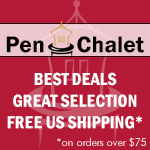While my wrist is under wraps for the next few weeks I'm going to explore a few new ideas during what is normally my Monday review time slot.
Today, we make a mess.
Over the past week I've missed using my stationery immensely. I didn't touch a pen until Friday, and only then to see how bad my lefty handwriting was. It was passable, and could certainly do in a pinch. But my new, shorter, cast freed up my fingers enough to grip way back on any pen or pencil, which was even better.
But I'm still not comfortable working on a proper product review for my normal Monday time slot. It feels too weird to do it differently than I have done for almost 13 years. So this Monday, and the next several Mondays, I'm going to talk about whatever pops into my head. Luckily, that usually involves stationery in some shape or fashion.
Going almost a week without pens had me wanting to swim in the stuff this weekend. Sunday afternoon provided a great opportunity, with windows-open weather, and the Masters in the background. I went around the house and gathered up all the things I've been wanting to use and piled them up on my dinner table. Yes, I thought. Back to normal.
I went through my inked fountain pens to make sure they haven't dried out from inactivity (one had, but it was more due to the fact it had almost been written dry,) and cracked open some new uni-ball products sent to me by their new US offshoot.
I grabbed my bills (I got a bit behind), and my books, and made sure to grab my creative journal to play around with. There was a bag of pencils, a sharpener, a bunch of washi tape, and a notebook, or two.
And I just played around. How were the new uni-ball Vision 0.38 mm pens? Surprisingly good. Can I use scissors with my right hand? Yes, quite well in fact. Is a wooden pencil the best writing instrument for me right now? It sure seems that way.
Softer and darker cores are better for me right now, I've discovered. My grip pressure is lighter, and further away from the page, so a pencil like the Blackwing MMX works well, when normally it isn't a consideration.
I used that pencil to copy one of my early favorite poems from my first Billy Collins book. Well, to start copying, because I could feel my arm pressure begin to tighten up inside my normally loose cast. Too much stress for today. Oh well. My wife probably won't appreciate the cast marks on the edge of the table either. Nobody tell her, ok?
I'm writing this post in the Ulysses app on my phone, where I have also taken and edited these average photos. I've been typing with my left hand on my phone a lot. It's more comfortable than my laptop sometimes, and Myke shared with me the amazing swipe to type feature, which I didn't know was built in to the iOS keyboard already. Oops.
I still need, and love, all of the digital hardware and software that allows me to do my job, but dang if this mess on this table on a random November afternoon didn't put a smile on my face.
Time to go play some more.






















